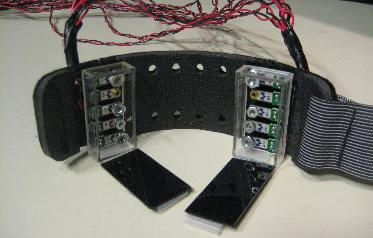Microsoft in collaboration with the University of Washington and the University of Toronto have begun spending some serious time and money developing muscle gesture technology for use with the Microsoft Surface (which is essentially a giant interactive touch screen.) This allows users of MS Surface to use variables such as pressure and gestures to fulfill different commands in the program. The technology also identifies which fingers are being used and will respond accordingly by assigning say different colors to each finger, allowing the user to finger paint a digital masterpiece.
Continuing development, Microsoft explored Forearm Electromyography (EMG) to take the physical interface out of the scenario. Although wired, Microsoft is currently looking into a wireless armband approach using EMG to track muscle movement where no physical device is present allowing one to unlock the trunk of a car while their hands are full. (For this and other examples of Microsoft's EMG technology, see the video below from 0:58-2:16.)
EMG muscle recognition is only one direction the future of electronics may head. The other is what is known as "Skinput." Chris Harrison at Carnegie Mellon's Human Computer Interaction Institute developed his own system similar in idea to the EMG system used by Microsoft, however unique in method. His system actually measures the acoustics of the human body and converts contact into commands that may control a number of electronic devices. (See 0:40-:056 of the blow video.) By using a monitor placed in an arm band (image to the right), Skinput calculates acoustic variables such as bone density and location to dictate commands to a specific device.
With the use of a fairly small pico projector, a visible digital interface can be... well... projected onto the user's forearm. (See 2:07-3:05 of the below video.) Skinput combines hand gestures commonly used to in a completely new and exciting way. Depending on where on the user's fingers, palm, wrist or forearm is tapped, one can easily scroll through a list of their favorite musical artists, skip songs being played back, dial phone calls, or play video games right on one's hand using gestures such as taps, pinches, or flicks with the fingers.
After further development, it isn't difficult to foresee this kind of hands-on technology becoming smaller, inconspicuous, and perhaps even fashionable to wear. It may even become universally compatible with most electronic devices. No one will ever have to worry about dropping their iPod or their cell phone again, as they can be left in your backpack with your books and lunch, and those precious touch screens won't be accidentally broken or cracked. However, even if they are, Skinput allows the functionality of those devices to remain... on your arm.
-Shaun B.
No comments:
Post a Comment